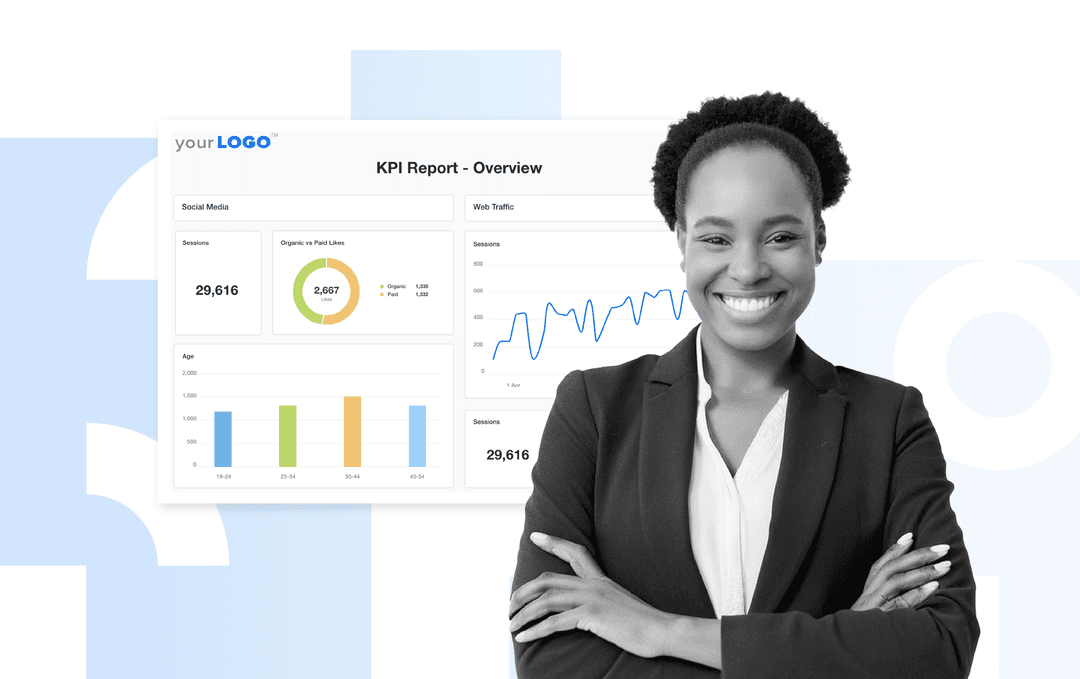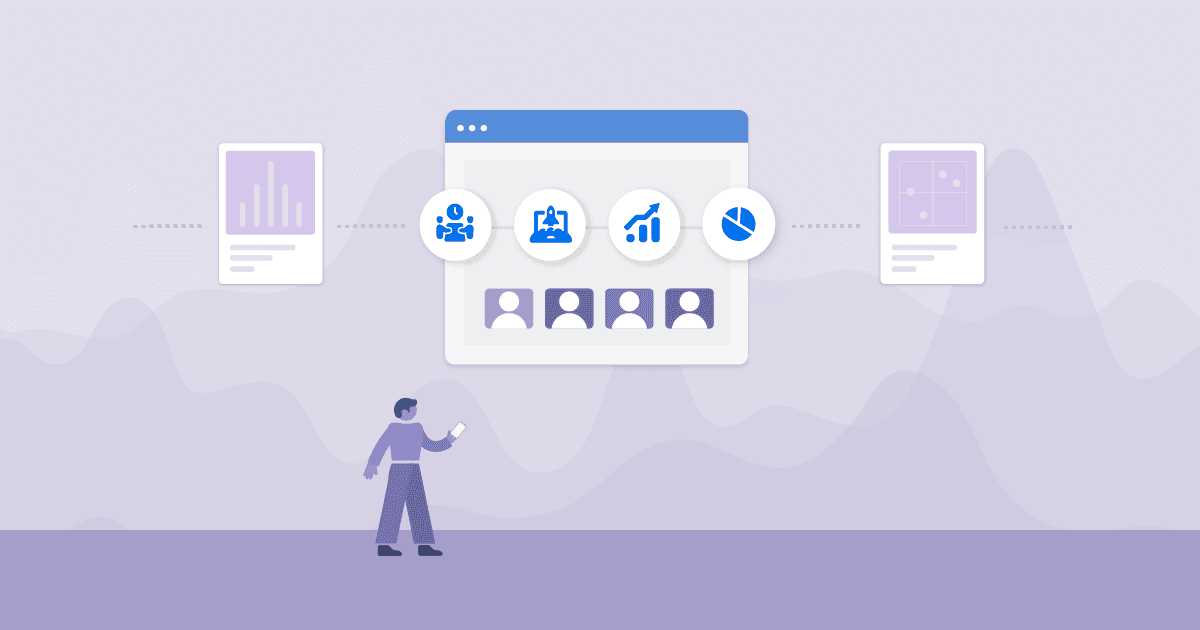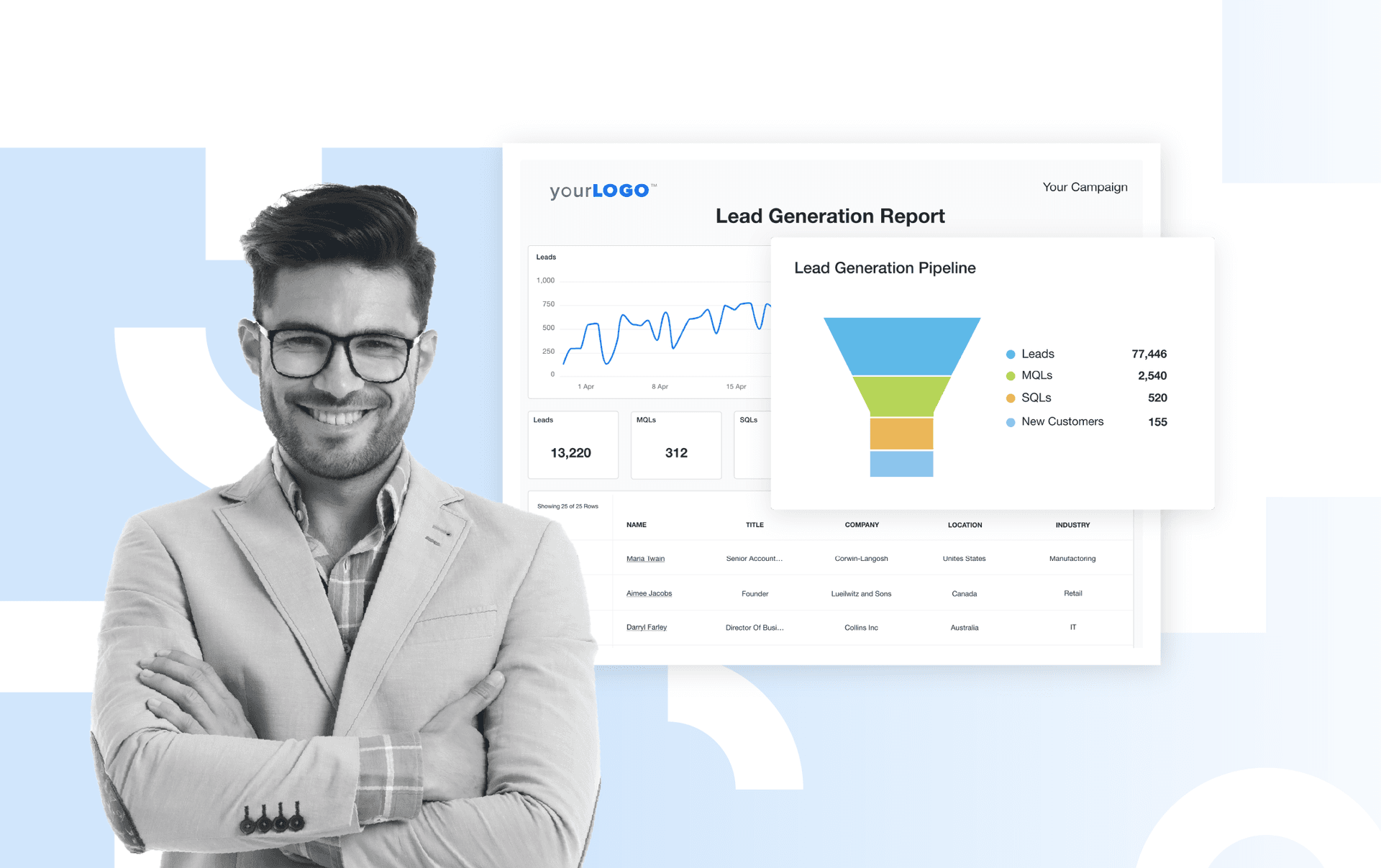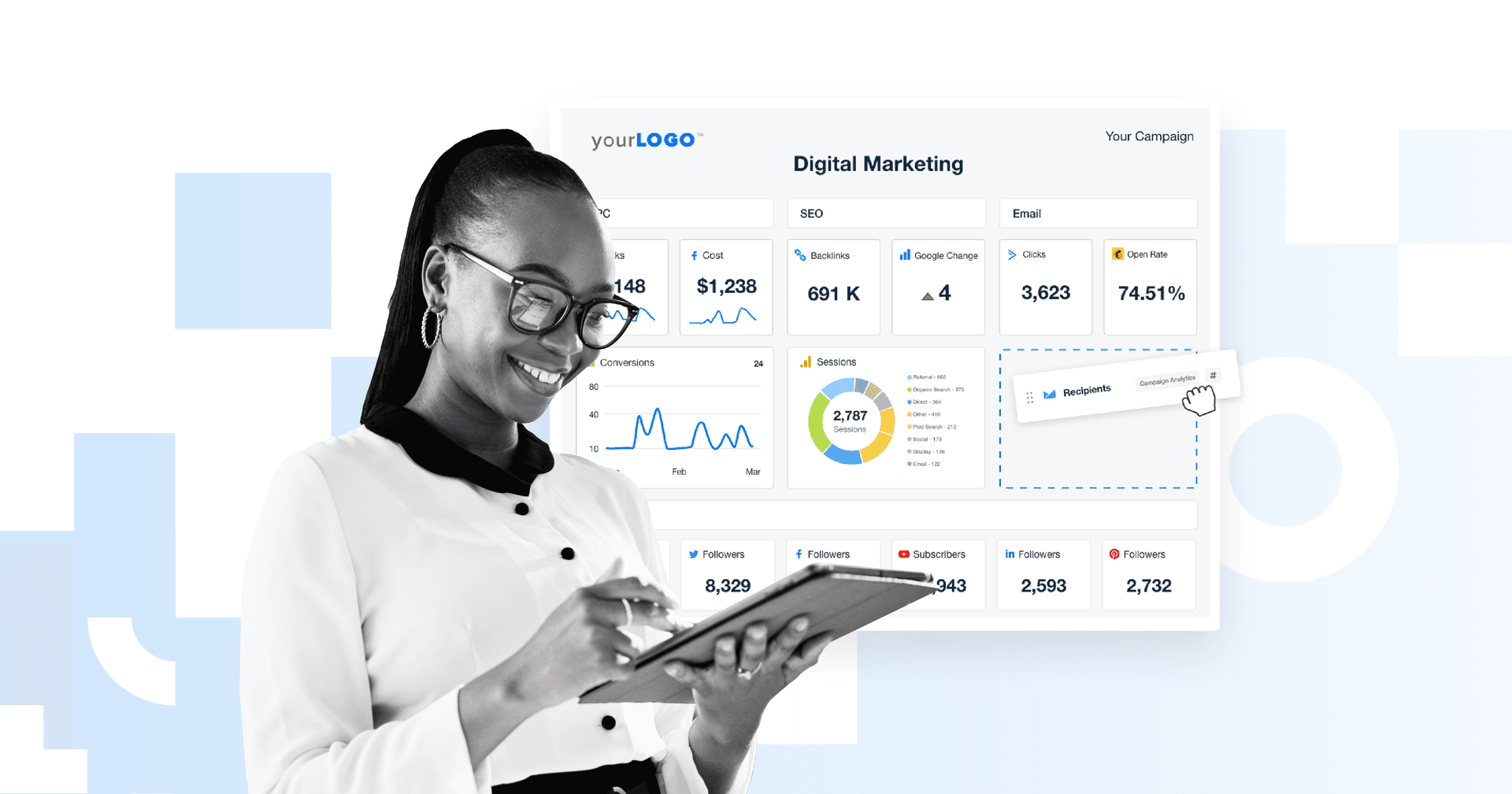Table of Contents
QUICK SUMMARY:
A marketing KPI template makes tracking KPIs simple and turns data into a story clients trust. Spot insights, prove each campaign supports your marketing strategy, and keep your KPI dashboard focused on improving client outcomes. This guide shares eight templates any agency can tailor to keep reports clear and results front and center.
It’s Monday morning. You’ve got a client update in five minutes and a dozen slides to finish. Social metrics here. Paid ads there. And the one metric they actually care about? Buried somewhere in the 47 tabs living rent-free in your browser.
For agencies juggling multiple clients, this mess is all too familiar. The fix? A marketing KPI template that pulls all that scattered data into a client-ready report faster than you can say–“Mind if we reschedule?”
Whether you’re tracking SEO, PPC, or social media, these eight templates keep your reports sharp and your value clear. So take a breath and close out some tabs because KPI reporting is about to get a whole lot easier.
To really understand performance you need a range of KPIs and they need to be analysed together. Traffic is no good unless you understand what keywords are driving that traffic and whether they're generating conversions or sales.
Paul Morris, Managing Director, Superb Digital
What is KPI tracking and why it’s critical
Big goals, tight deadlines, constant client check-ins–agency life is all about hustle. But for that hustle to pay off, you need to prove your marketing strategy gets real results. That starts with tracking your online marketing performance with clear, relevant KPIs.
Key performance indicators (KPIs) are the numbers that show what’s working (and what’s not) by measuring how your marketing campaigns stack up against your client’s goals.
They answer the basics like:
Is that ad driving sales or just clicks?
Is organic traffic bringing in real leads?
Did last month’s social push build loyalty or just inflate vanity metrics?
But here’s the catch: not every KPI is useful on its own. To really prove impact, your KPIs need to be SMART.
What are SMART KPIs exactly? They stick to five simple rules:
Specific: Clear and focused.
Measurable: Tied to a real number.
Achievable: Realistic with your budget.
Relevant: Supports bigger client goals.
Time-bound: Has a deadline, no open-ended wishes here.
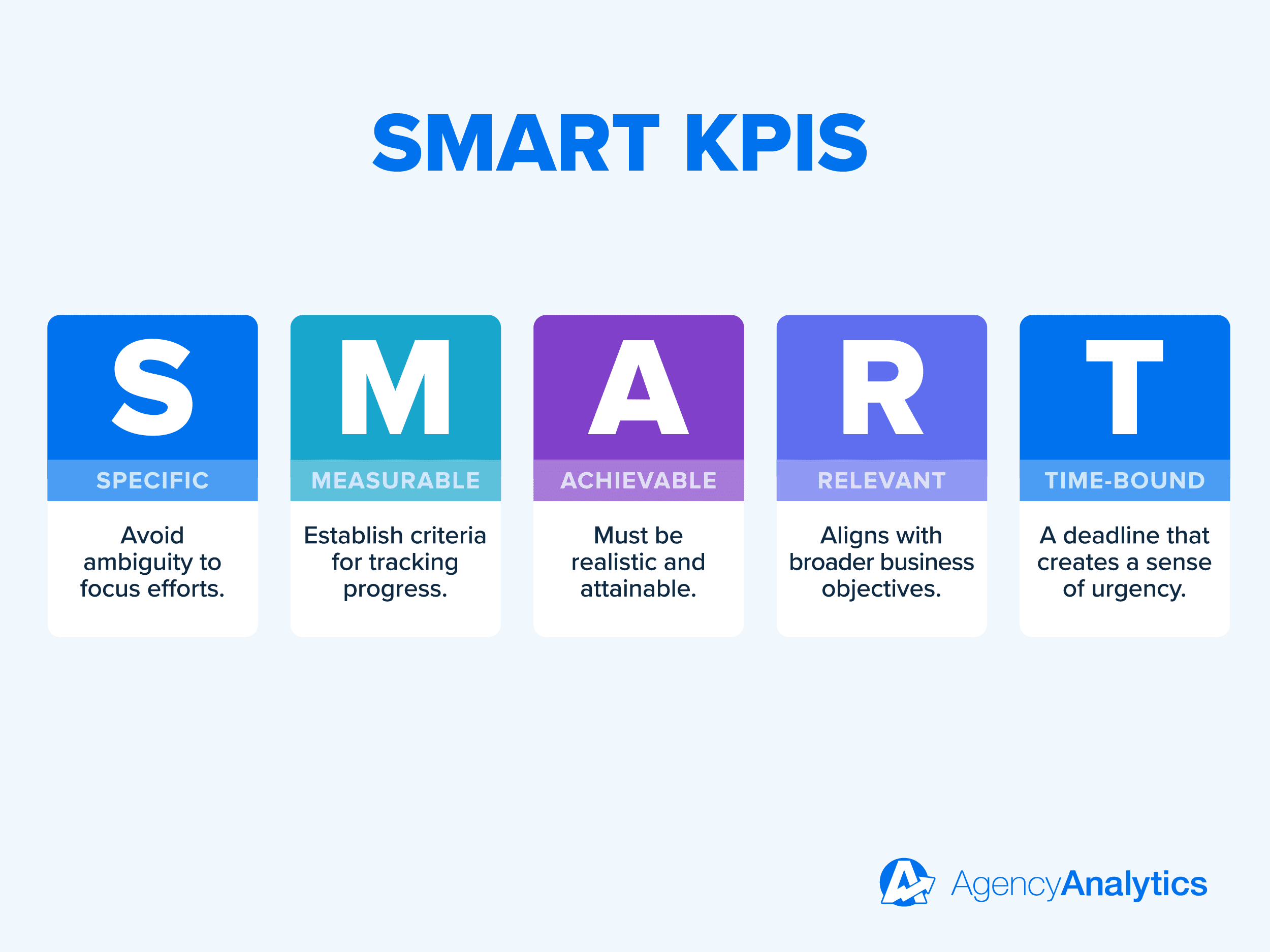
For example: Instead of a vague goal like “Increase social engagement,” a SMART KPI would be "Grow Instagram engagement by 15% over the next quarter.”
Track key performance indicators against SMART goals and you’ll spot wins faster, catch hiccups early, and walk into every client meeting knowing exactly what’s working–and why.
During the sales process, we ask the client what KPIs they want to track, often they're unsure and so we make recommendations based on their overall goals.
Paul Morris, Managing Director, Superb Digital
Why use a marketing KPI template for tracking analytics?
If your reporting process involves chasing marketing KPIs across six tools and a pile of spreadsheets, it’s time for a fix. KPI dashboard templates pull all your data into one, centralized place, so the story (read: success) behind the numbers is impossible to ignore. Let’s say your client is gearing up for a big event and wants to drive traffic to their sign-up page. To bring visitors in, you run marketing campaigns across multiple marketing channels: paid ads, social media posts, and email blasts.
Here’s how tracking marketing analytics works without a consolidated KPI template:
You might pull click-through rates from each social media platform, check Google Ads performance separately, and monitor website traffic, conversion rates, and bounce rates through Google Analytics. Then you dig into email metrics for open and click rates. Every piece of marketing data is in a different place. Making sense of what’s actually driving results turns into a time-consuming mess of browser tabs, exports, and spreadsheets.
And with a template?
Everything’s in one, centralized location. Your client’s social media KPIs, Google Ads, email performance, and Google analytics data pull into a single dashboard. You’ll catch patterns early–like a spike in paid impressions but no lift in site visits, signalling a landing page issue. Or high email click rates but flat conversions, pointing to a weak CTA.
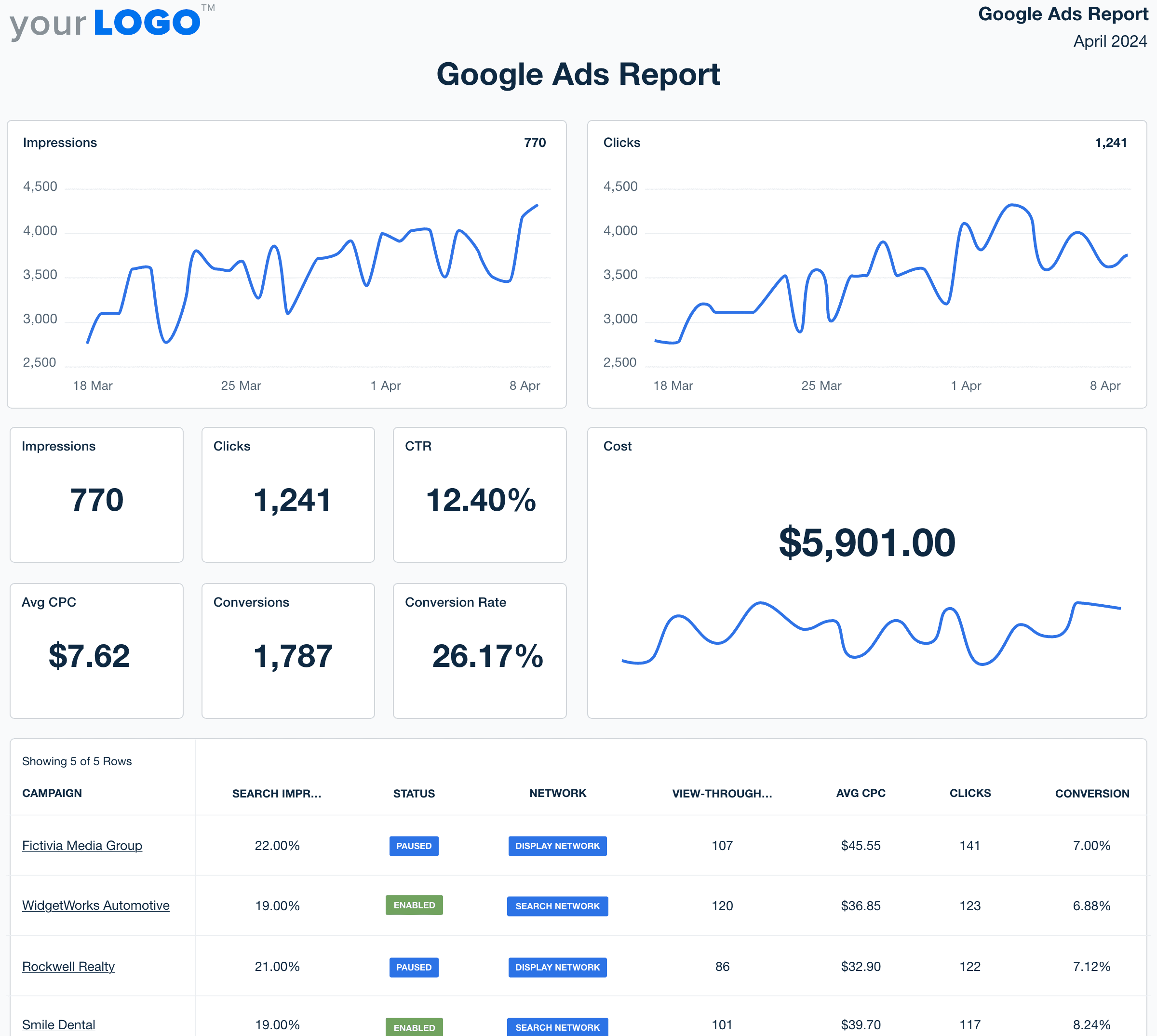
Marketing KPI templates don’t just organize your data. They spotlight KPI trends so you can act on them fast. Instead of reacting to missed targets or late-stage performance drops, your team monitors progress and makes real-time adjustments that take your agency’s results to the next level.
But it’s not just about clients, it’s about your agency too. Having a simple way to show essential metrics that are consistent, clear, and easy to share (even when teams change or deadlines stack up) makes everything run smoother. Covering holiday sales? Filling in for a teammate on vacation? Templates make it easy for anyone to jump in and continue serving your clients.
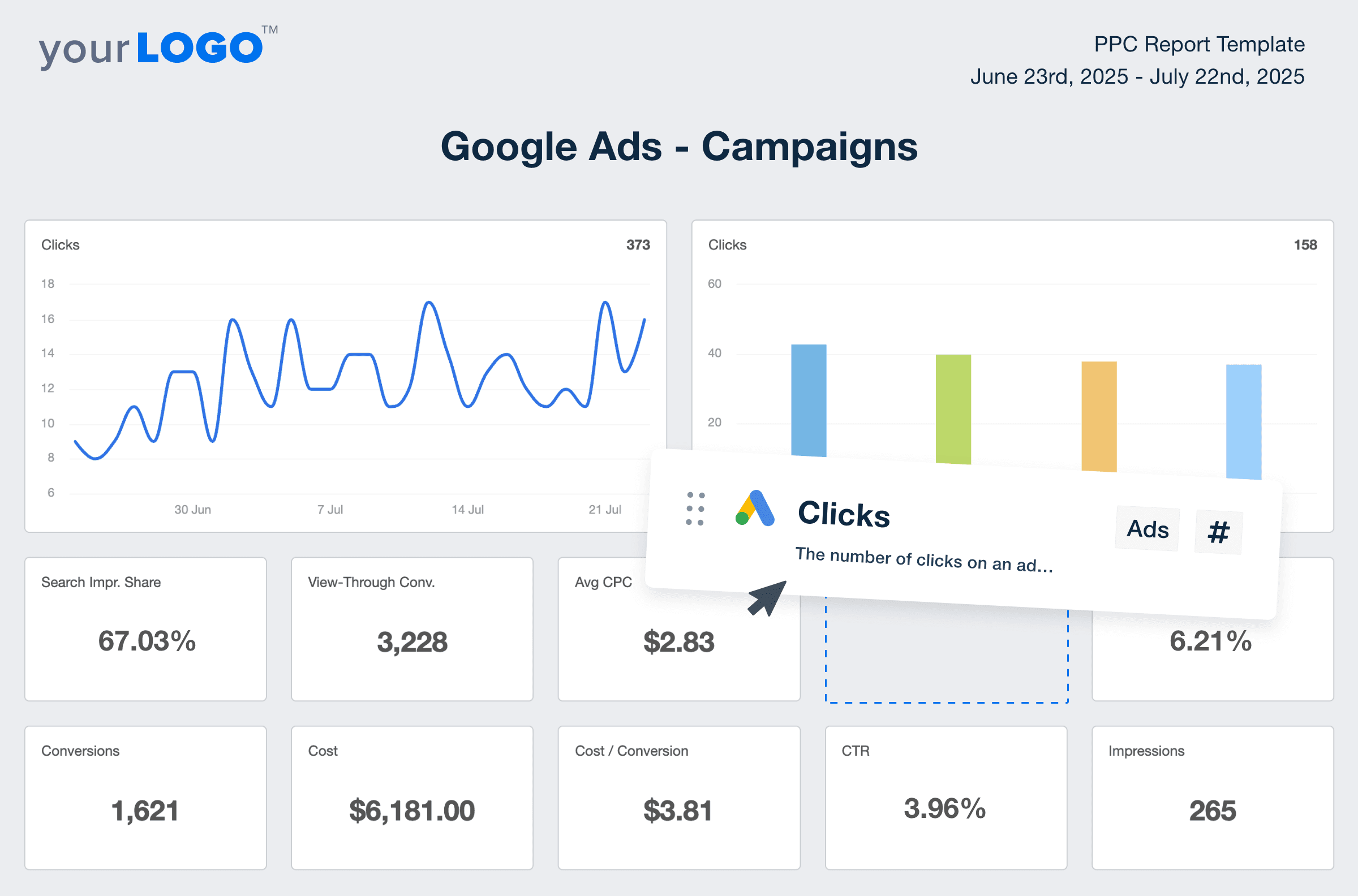
Ready to start reporting smarter, not harder? Get actionable insights, spot performance trends at a glance, and keep your reporting process smooth. Start your free trial today.
Track your digital marketing analytics with these 8 Marketing KPI tracking templates
Whether you’re tracking Instagram engagement, website analytics, or SEO growth, clients want one clear answer: Is this campaign worth the budget? These marketing KPI templates map every click, scroll, and sign-up back to bigger goals–in seconds, not spreadsheets.
1. KPI reporting template
Think of a KPI Report Template as a report card that tells you how well your client’s marketing budget is performing. While the exact KPIs you track will change, they should always reflect the goals that matter to each individual client.
For ecommerce clients, track key performance indicators like:
Revenue Generated: Clear proof that marketing campaigns are driving sales, not just clicks.
Cost Per Lead (CPL): Shows what customer acquisition really costs. Think of it as your guardrail for paid campaigns. If CPL creeps up, it’s a sign to revisit targeting or ad spend before it eats into profit.
Average Order Value (AOV): Keeps upsell or bundle strategies on track.
Repeat Purchase Rate: A core customer retention KPI that shows loyalty and future value at a glance. It’s a quick, reliable snapshot of customer lifetime value.
For B2B SaaS clients, swap in lead quality, lead-to-demo ratio, pipeline value, and churn trends, so their sales teams know which deals need love and which ones close themselves.
We have used other reporting templates in the past but AgencyAnalytics templates are not only easy to use as an agency but they are great for our partners to easily view the KPI's and digest the information in a fast efficient way.
Justin Hual, Co-Founder and COO, HIP Creative
2. Social media KPI reporting template
Social media hands you plenty of vanity metrics–likes, views, follows that don’t always translate to better business performance. A social media report template keeps the focus on numbers that actually matter.
Here are a few social media KPIs to include:
Engagement Rate: Likes, comments, shares—the pulse check for relevance and customer satisfaction.
Audience Growth: Tracks steady follower gains instead of random spikes.
Click-Through Rate (CTR): Shows how posts drive website traffic beyond the feed.
Conversion Rates: The metric that proves social brings in real ROI from your client’s marketing spend.
Example: A local restaurant cares more about clicks to reservations than reach. A national brand may watch branded hashtag use to measure buzz and word-of-mouth.
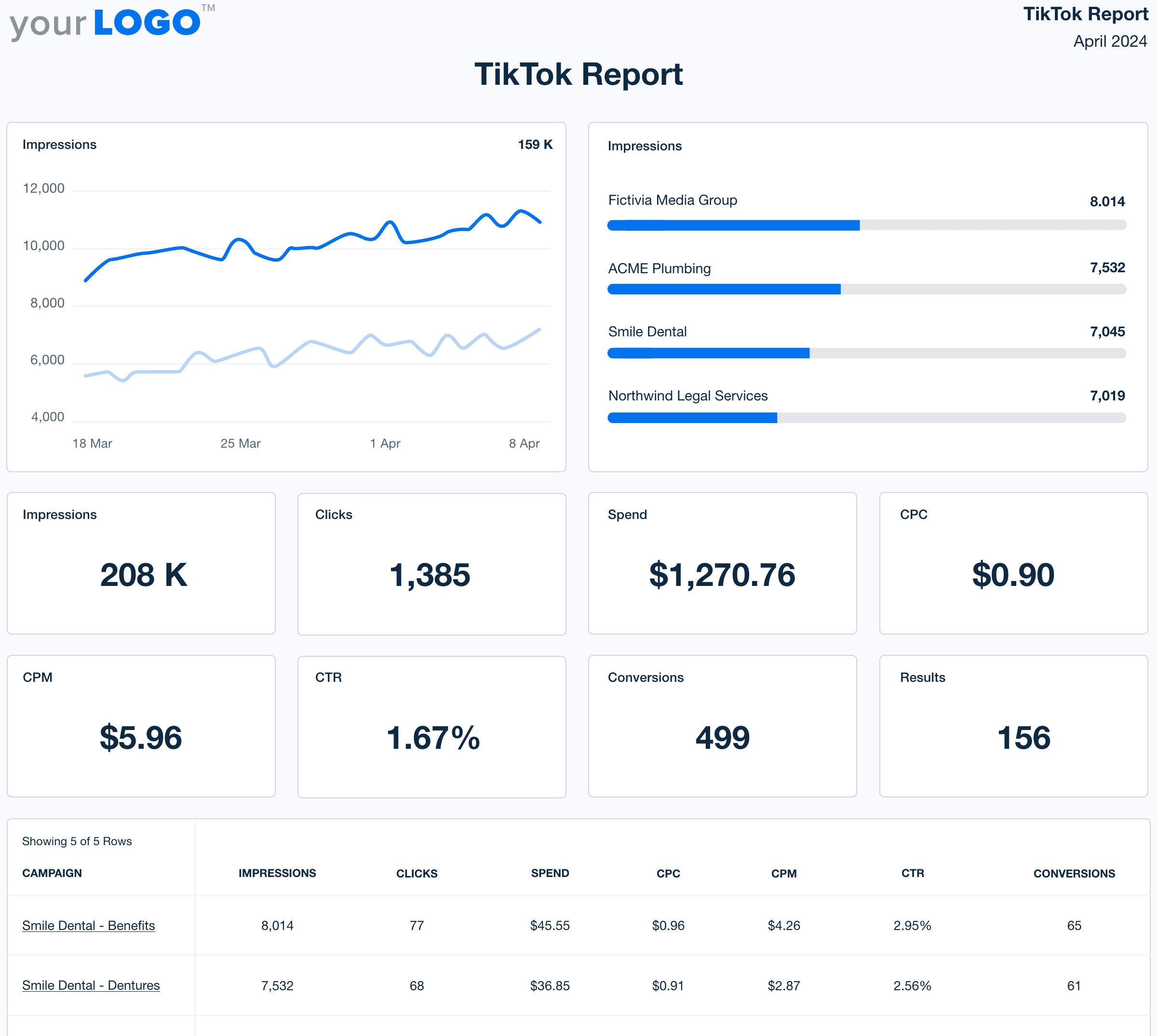
AgencyAnalytics' live dashboards track social media engagement across TikTok, Instagram, and LinkedIn—so you’ll quickly spot which channels drive qualified leads and double down where it counts.
3. Facebook KPI reporting template
Not every like is worth celebrating, especially when you’re paying for it. The real value shows up when reach turns into clicks, clicks turn into leads, and leads turn into revenue.
Our Facebook KPI Reporting Template zeroes in on what matters, like:
Cost Per Click (CPC): Tracks how efficiently marketing spend turns into visits.
Click-Through Rate (CTR): Highlights when ads grab attention or fall flat.
Conversion Rate: The percentage of clicks that translate to sales, sign-ups, or bookings.
Engagement Rate: Adds context for reactions, but only if they help drive action.
Agency Tip: Facebook numbers falling short? Don’t start from scratch. Refresh top ads with a new headline or visual. And watch ad frequency–overexposure burns through marketing spend fast and kills results.
4. Instagram KPI reporting template
Pretty pictures alone don’t pay the bills. Instagram works best when it turns scrolls into clicks, and clicks into actions clients care about.
Use our Instagram KPI Reporting Template to spotlight:
Reach: Shows how many unique users see your client’s content.
Impressions: Total views–useful for spotting repeat exposure.
Saves and Shares: Signals what content followers find worth revisiting or passing along.
Profile Clicks and Website Visits: Connects posts to website traffic.
Branded Hashtag Use: Great for product launches and influencer pushes.
Agency Tip: Running a promo? Keep tabs on story swipe-ups and branded hashtag mentions to measure performance and see if curiosity turns into clicks. If saves climb but shares stall, switch up your format or test a sharper caption to get people spreading the word. Then pull sample data from past campaigns to spot KPI trends fast. Use what worked to guide new visuals and double down on what gets clicks.
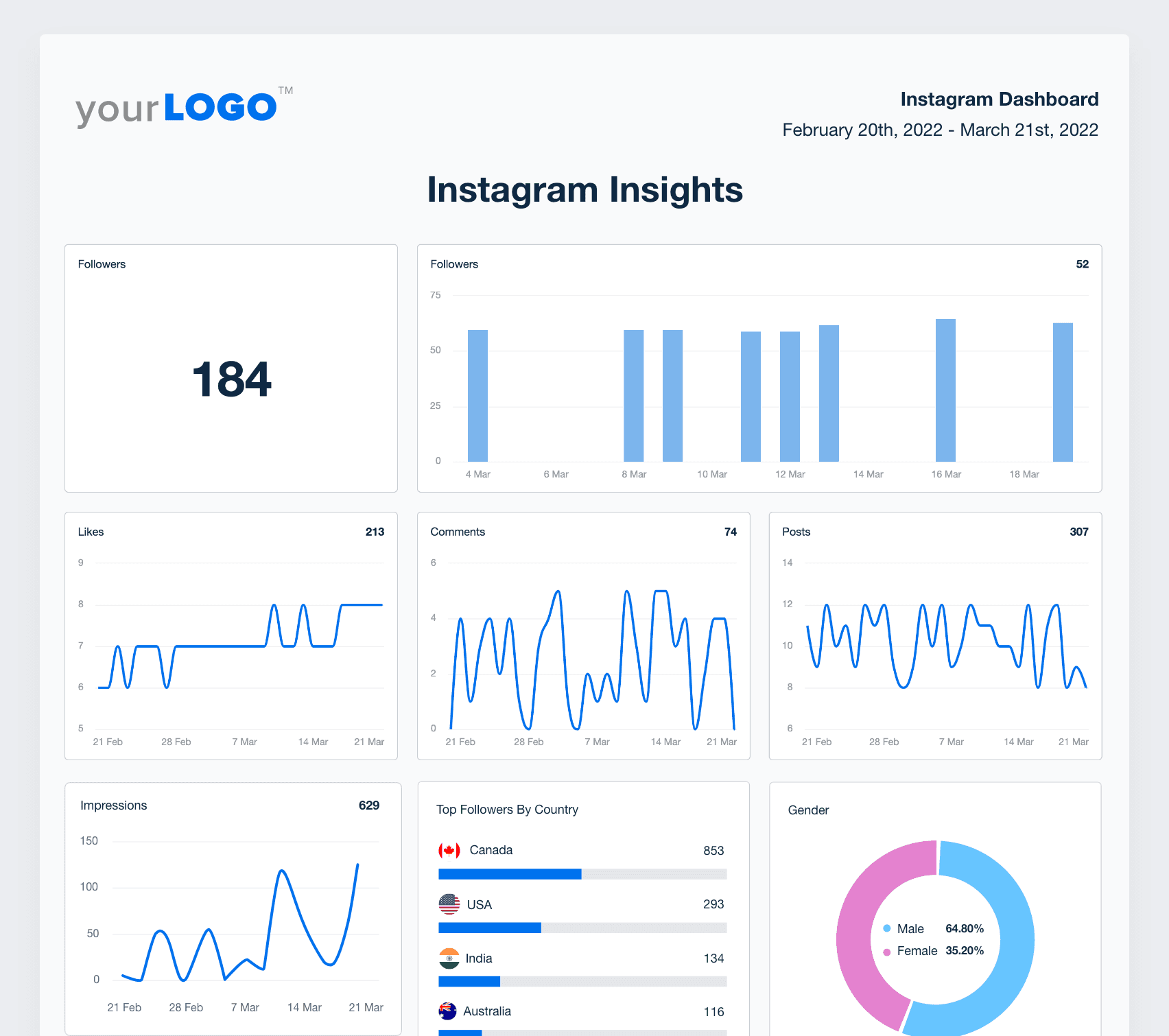
Ready to track all your client’s social media metrics without platform-hopping? Build your first custom report with AgencyAnalytics–or snag a template. Start your free 14-day trial today.
5. SEO KPI reporting template
SEO won’t wow overnight, but when done right, it keeps organic traffic flowing long after paid ads pause.
To show your agency’s progress, stick to critical SEO KPIs like:
Organic Sessions: How many visitors land from search.
Keyword Rankings: Which target terms are climbing or slipping.
Backlinks Earned: Tracks off-page efforts and authority gains.
Conversions From Organic Pages: Connects rankings to marketing qualified leads or sales.
For local clients (like restaurants or brick-and-mortar stores) you’ll also want to track Map Pack visibility and Google Business Profile clicks to prove your local SEO strategy is working.
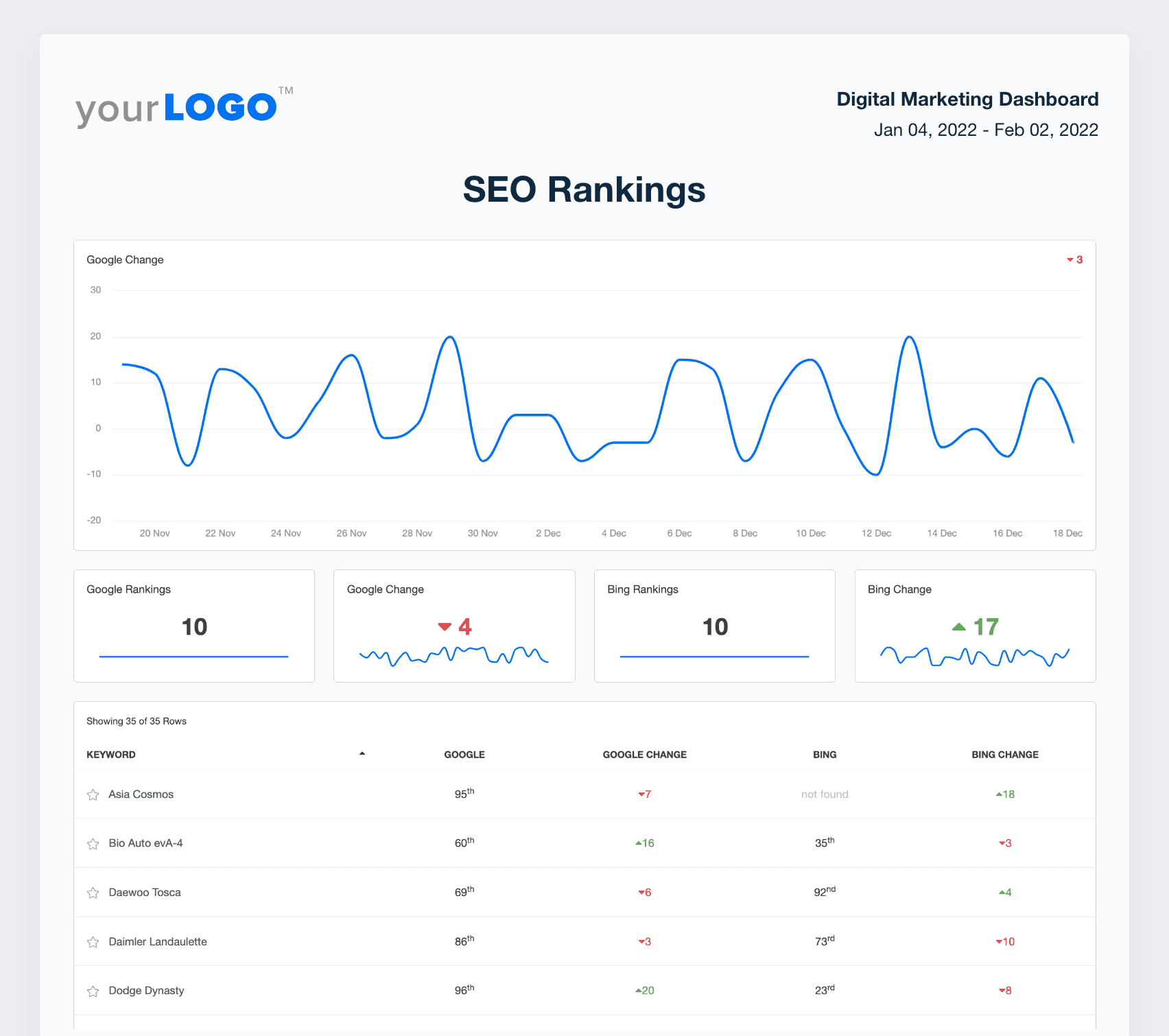
Agency Tip: Got a client with a content-heavy site? Don’t let old posts drag down performance. Flag what’s still pulling traffic and what’s gone stale. Link content updates back to your content marketing KPIs, so they see what’s actually driving leads. A tighter title, sharper meta, or one well-placed internal link often keep rankings solid without a full overhaul.
Tired of pulling SEO insights out of thin air? Our SEO KPI Reporting Template puts everything you need in one place. So you can finally see which keyword rankings, organic sessions, backlinks, and conversions are making a difference for your clients.
6. Web analytics KPI reporting template
Traffic alone won’t impress a client, but what visitors do next will. Our Web Analytics KPI Reporting Template connects site activity to tangible results:
New and Returning Visitors: Spot audience loyalty and repeat interest.
Sessions: Tracks total visits to the site over time–because sometimes decisions take a few clicks.
Top Landing Pages: See which pages attract visitors best and which ones deserve an update. Check these alongside website KPIs to connect traffic to results.
Conversions By Source: Shows which marketing channels drive actions, not just clicks.
Agency Tip: For ecommerce clients, keep an eye on cart abandonment rates next to sessions and landing page views. You’ll catch drop-offs before they drain revenue. Got B2B clients? Track marketing KPIs like lead-to-demo conversion rate, cost per qualified lead, and sales qualified leads to show how website traffic turns into booked calls and pipeline value. If traffic spikes but sign-ups stall, check your UX and calls-to-action before spending more.
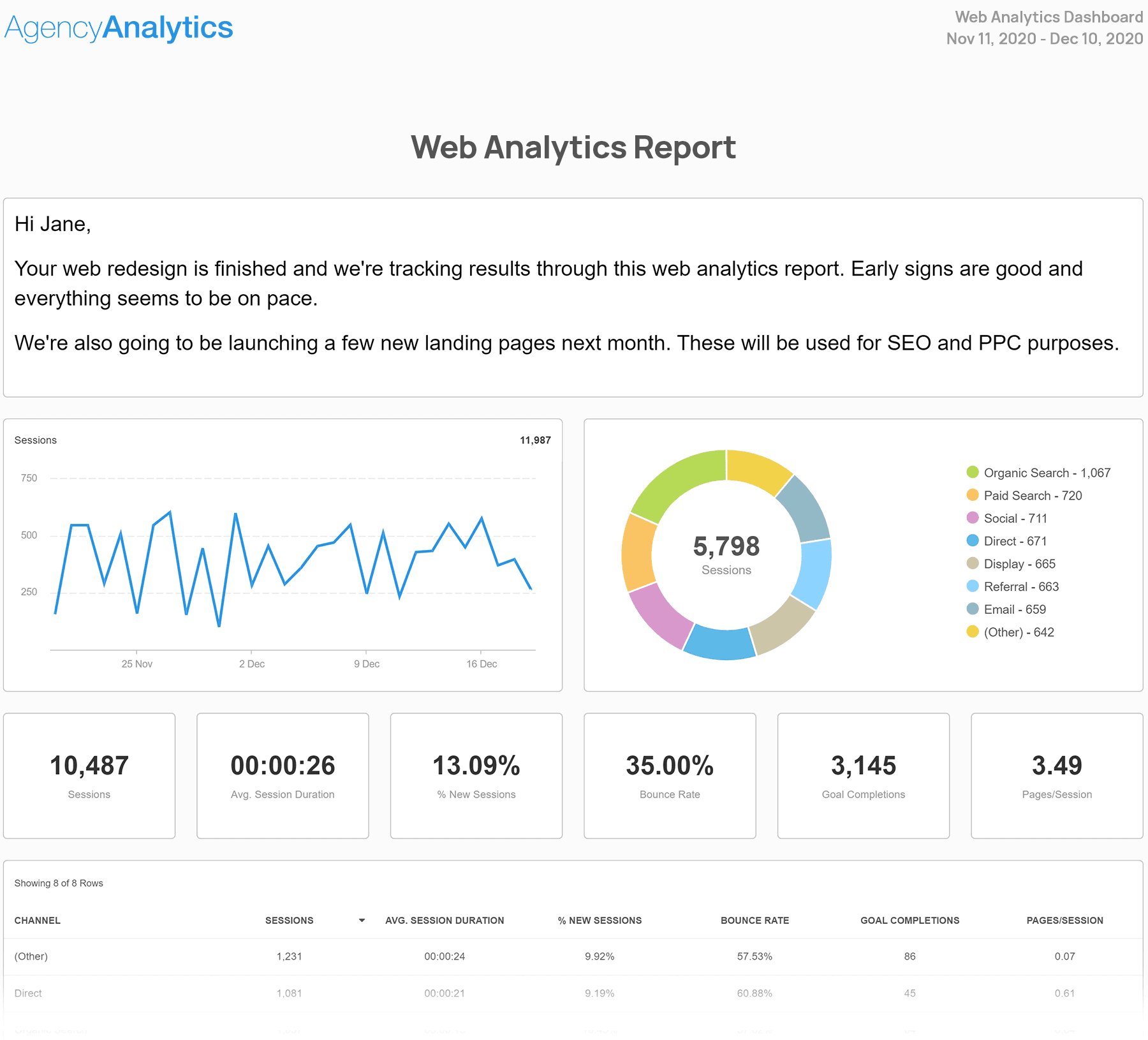
7. Email marketing KPI reporting template
Strong open rates feel great, but value only shows up when clicks turn into sign-ups, sales, or booked calls. Our Email Marketing KPI Reporting Template keeps each send focused on results that matter to your clients.
Keep an eye on these email KPIs:
Deliverability: Makes sure emails land in inboxes, not spam folders.
Open Rate: Shows if subject lines and send times are working.
Click-Through Rate (CTR): Measures how well your content inspires action.
Conversion Rates: Connects campaigns to actual leads and revenue.
Unsubscribes: Flags when your client’s list needs a refresh or your content needs a rethink.
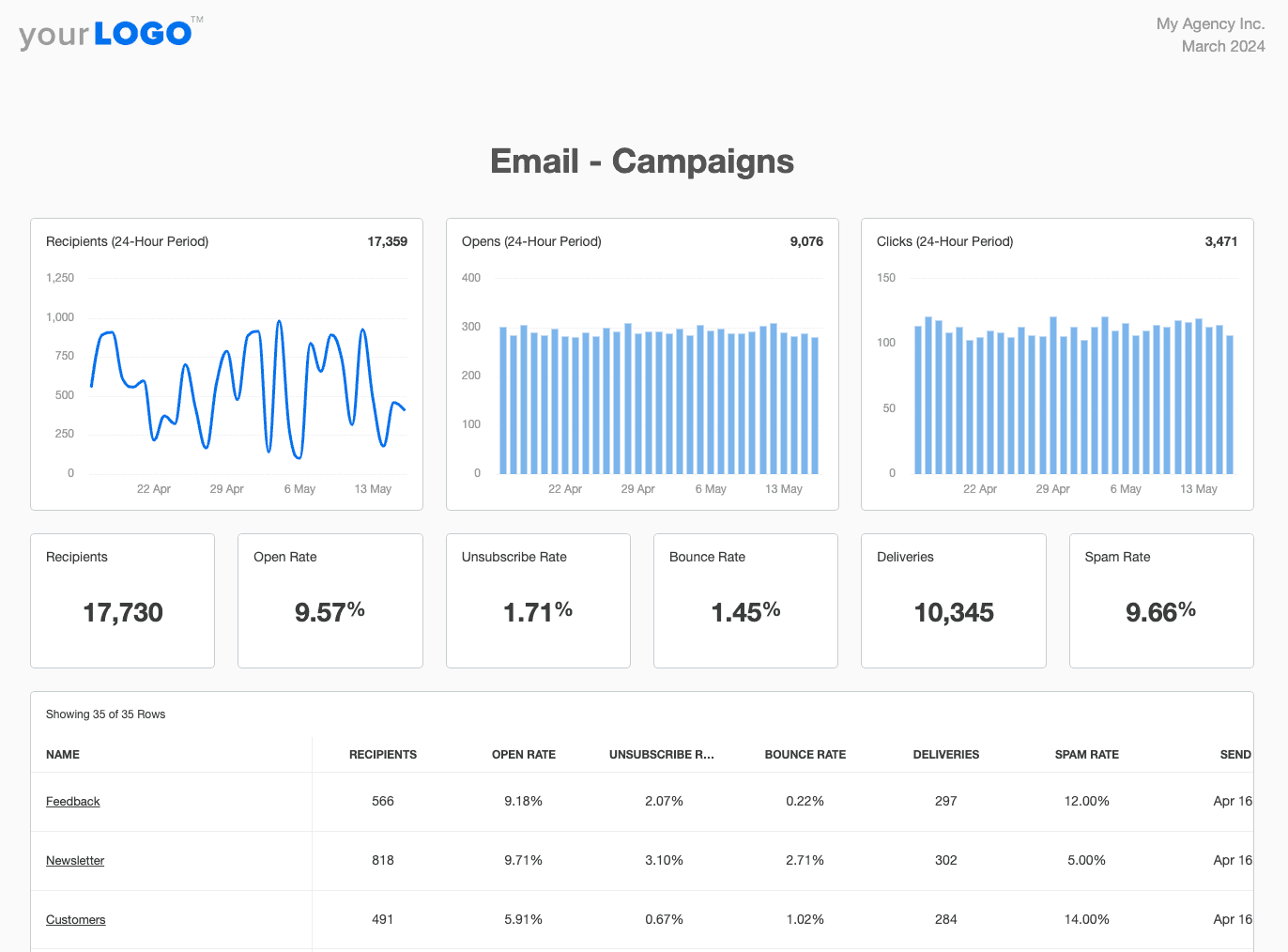
Agency Tip: For nurture flows, keep tabs on how clicks turn into qualified leads–not just traffic. Running a promo? Tie revenue straight back to each send to show real ROI. And if mobile opens drop but desktop clicks hold steady, it’s your sign to test shorter subject lines and clean up that layout.
8. Full-Service marketing KPI reporting template
Most clients don’t want to juggle ten different reports to figure out if their budget’s working. They want the full story in one place: how paid ads, organic traffic, social posts, and emails work together to hit their goals.
An all-in-one view pulls in data from every marketing channel and ties it to your KPI targets, like:
SEO Performance: Think organic sessions, keyword rankings, and search conversions that show people are finding (and trusting) your client’s site.
Paid Campaigns: Cost per click, click-through rate, and conversions–so you’re not just buying clicks, you’re earning results.
Social Media: Track engagement, audience growth, clicks, and conversions to show whether your content’s actually working or just getting likes.
Email and Website: Open and click rates, revenue per send, and top landing pages. Because if traffic’s landing but not sticking, it’s time for a tweak.
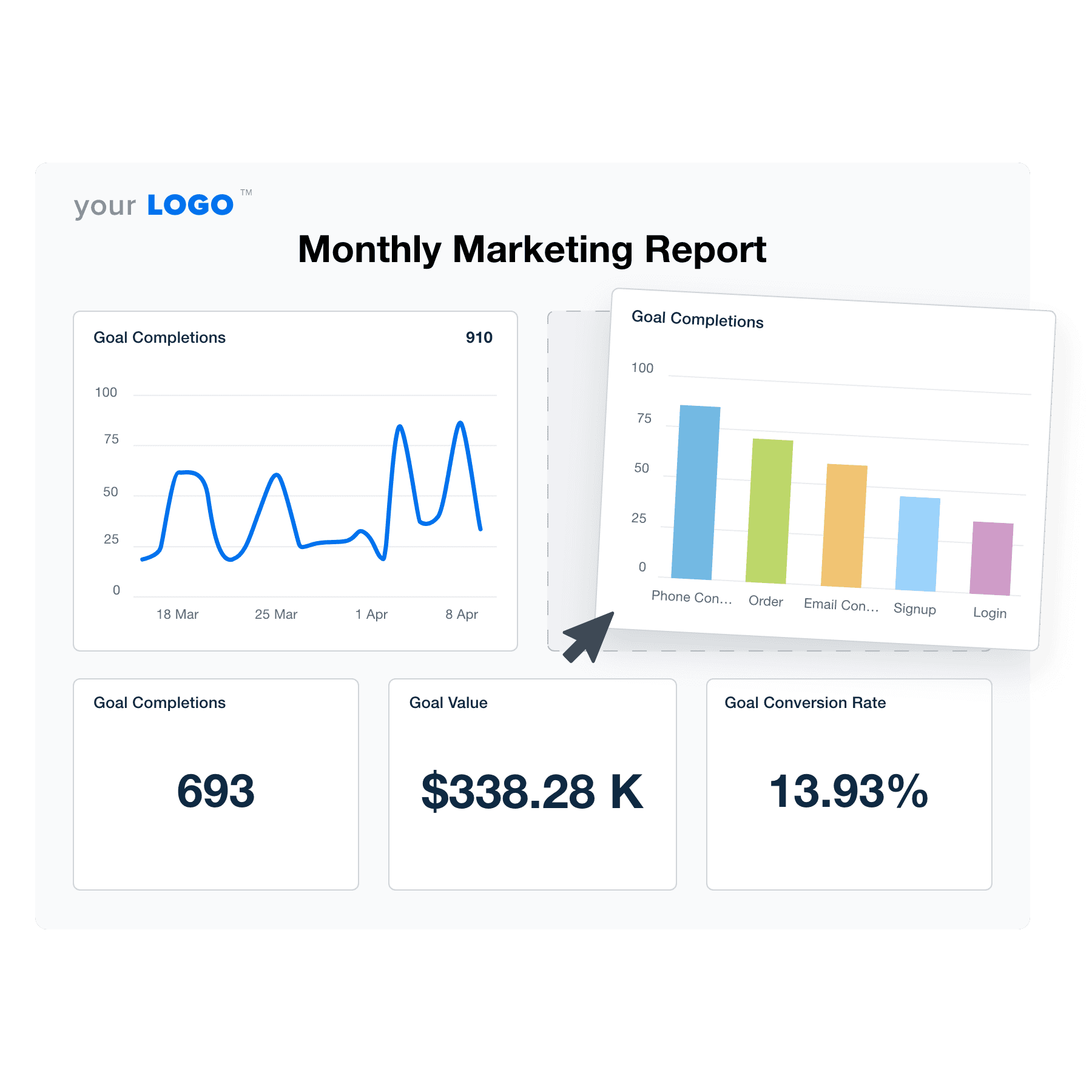
Bottom line? You need a big picture view to make big moves for your clients. Our All-Around Marketing Report Template brings all your marketing efforts together, from SEO pulling in organic leads to paid ads landing quick wins to email keeping loyal customers in the loop. And it does it without the last-minute scramble to stitch everything together.
Agency Tip: Take a peek at these KPI reporting examples to see what’s working for clients like yours. Then tweak your template without starting from scratch.
How to create a custom marketing KPI template with AgencyAnalytics
Building a custom KPI report shouldn’t eat up your time (or your patience). Here’s how to set up a marketing KPI template in four quick steps:
Step 1: Connect your client’s data sources
Plug in each marketing channel once from the over 80 data source connectors and AgencyAnalytics takes it from there. Live data flows straight into your customizable dashboards and reports, automatically.
Step 1: Pick a template or use the drag-and-drop editor to create your own
Start with a ready-made KPI report that highlights the channels you’re managing for your clients. Paid, social, email, or all of the above? There’s a reporting template that puts everything in one place.
Or, if you'd prefer, use the visual drag-and-drop editor to create a custom template that reflects your exact needs. Don't forget to set up your white label preferences so that every marketing KPI template reflects your agency's brand!
Step 3: Customize the marketing metrics
Add or remove KPIs to match each client’s goals. Highlight targets, flag wins, explain any surprise dips–it’s all drag-and-drop easy.
At our agency, we believe that metrics are only useful if they help to drive decision-making. As a result, we focus on identifying actionable metrics that can be used to inform and improve our marketing efforts.
To do this, we start by taking a close look at our goals and objectives. We then identify the key performance indicators (KPIs) that will help us measure progress towards those goals. Once we have a clear understanding of our KPIs, we can choose the metrics that will provide the most insights into our performance.
By taking this approach, we ensure that our metrics are always actionable and informative.
Guy Hudson, Founder, Bespoke Marketing Plans
Step 4: Automate and share
Schedule reports to send automatically and give clients a live marketing dashboard they can check anytime. No extra emails. No “just checking in” calls. They get answers when they need them—and you get your time back.
Once you’ve got it dialed in, your template keeps KPI tracking clear and consistent while dashboard automation frees up hours you’d usually spend pulling numbers by hand. One setup, a few clicks, and your team’s updates run themselves.
Final Thoughts: Save time and report smarter
Twelve spreadsheets. Too many tabs. One more late night scrambling for numbers. It adds up fast–and you’ve got better things to do.
AgencyAnalytics KPI templates make reporting simple, clear, and efficient. Track every metric in one place, automate the updates, and skip hours of manual work every week. Your clients get the insights they need. You get your time back.
Skip the scramble. Get your hours back. Start your free 14-day trial today.
Impress clients and save hours with custom, automated reporting.
Join 7,000+ agencies that create reports in under 30 minutes per client using AgencyAnalytics. Get started for free. No credit card required.
FAQs about marketing KPI templates
Easy answers to help your agency make KPI reporting clear, strategic, and scalable for every cClient
Setting effective KPIs starts with connecting your marketing activities to measurable business objectives. Begin by understanding what success truly looks like for your client—more leads, higher revenue, stronger retention, or improved ROI. From there, choose quantitative measures that reflect progress toward those goals, such as website traffic, lead volume, conversion rates, or cost per acquisition.
Next, map data sources for each KPI so your marketing team can analyze data accurately and consistently. Use a marketing KPI template to ensure a standardized workflow across campaigns, channels, and reporting periods.
Finally, assign defined targets and timelines so your team knows what “good” looks like. Clear KPIs keep your reporting focused, support data-driven decisions, and directly tie your marketing investment to real business outcomes.
Although marketing can feel complex, most example digital marketing KPI strategies anchor to three simple principles: Traffic, Conversion, and Economics.
Traffic: How many qualified users arrive onsite or into the funnel? Metrics like sessions, impressions, and channel performance help determine how effectively campaigns attract attention.
Conversion: How efficiently traffic turns into leads, sales, or pipeline opportunties. Lead quality, conversion rate, and sales KPIs show whether the right audience is taking the right actions.
Economics: The financial impact—including marketing ROI, profit margins, gross profit margin, and return on ad spend.
Together, these principles provide a holistic view of effectiveness. When built into a repeatable KPI reporting template, they help agencies make smarter strategic decisions and justify budget recommendations with confidence.
A KPI report template delivers several advantages that make reporting faster, clearer, and more strategic:
Creates a repeatable reporting framework that turns raw KPI data into meaningful, client-ready insights
Aligns metrics with business goals, ensuring you highlight what actually drives performance
Centralizes data from multiple sources (SEO, PPC, email, social, website analytics, CRM) into one consistent view
Standardizes data collection so your entire marketing team reports KPIs the same way
Improves accuracy and reduces manual work, eliminating copy/paste errors and spreadsheet maintenance
Delivers consistent charts and line graphs that make KPI trends easy for clients to understand
Enhances collaboration by giving your team a shared structure for defining metrics and reporting results
Keeps reporting focused on meaningful KPIs, not vanity metrics, so insights support real business objectives
Excel works for quick snapshots or enhanced filtering, but it breaks down fast when handling complex campaigns, multiple clients, or evolving marketing tools. Manual entry introduces human error, slows down reporting, and forces your team to spend hours copying, pasting, and troubleshooting formulas.
An automated digital marketing KPI template streamlines everything. It pulls KPI data directly from integrated sources, updates dashboards in real time, and eliminates repetitive work. You get clean visualizations, easier collaboration, and deeper insights—without maintaining endless spreadsheets, pivot tables, or custom macros.
It’s also far more scalable. Whether you're reporting on ten clients or hundreds, automated dashboards allow your marketing manager and analysts to spend more time improving team’s performance, not rebuilding the same report each month.
A strong marketing KPI template keeps reporting clear, actionable, and aligned to top-level strategic goals. While formats vary, most templates include:
A summary of business goals and defined KPI targets
Key campaign KPIs (traffic, conversions, revenue, ROAS)
Channel-level performance metrics
Visualizations such as line graphs and heat maps
Insights tied to marketing investment and profitability
A section for recommendations and next steps
Templates should also support data from multiple sources—SEO tools, CRM systems, analytics platforms, paid ads, and email service providers. When structured well, a digital marketing KPI template becomes a powerful tool that helps clients quickly understand performance and enables your agency to make corrective, proactive, and data-driven decisions efficiently.
Depending on the complexity, most agencies spend anywhere from 45 minutes to a few hours designing a comprehensive KPI dashboard, connecting integrations, choosing KPIs, and tailoring visualizations to match client business outcomes. But the upfront time investment pays off exponentially when it comes to reporting time!
Once the template is set up, reporting becomes nearly effortless. Data updates automatically, KPIs populate in real time, and scheduled reports deliver themselves. You avoid rebuilding reports from scratch, reduce manual errors, and give your team more time to focus on strategy.
In short: create the template once—then let the reports (basically) run themselves.
A strong digital marketing KPI strategy blends traffic, conversion, and financial indicators to show whether campaigns are actually driving business outcomes. Common examples include website traffic, keyword rankings, engagement rates, conversion rate, cost per acquisition, return on ad spend, and customer lifetime value
Some agencies go even deeper by adding profitability metrics like gross profit margin and profit margins, which help leadership connect marketing investment to revenue. Retention-focused KPIs such as Net Promoter Score also matter when evaluating long-term brand health.
Many agencies are moving away from heavy BI platforms like Google Data Studio (now Looker Studio) for client reporting because those tools are built for analysts—not the pace and workflow of a busy marketing team when it comes to client reporting time.
BI tools often require manual data blending, connector maintenance, spreadsheet workarounds, and ongoing troubleshooting each time a client adds a new channel or changes their reporting needs.
AgencyAnalytics removes that friction entirely. With 80+ built-in marketing integrations, automated dashboards, and a drag-and-drop interface, agencies skip the setup headaches and get straight to insights. Reporting becomes faster, cleaner, and far easier for clients to understand.
Instead of rebuilding Looker reports or chasing down broken connectors, agencies rely on a platform designed specifically for marketing KPIs, defined targets, and streamlined client communication. The result is a powerful, purpose-built environment that supports up-to-date visibility and faster strategic decisions—without the BI complexity.

Written by
Kali Armstrong is a freelance content writer with nearly a decade of experience crafting engaging, results-driven copy. From SEO blogs to punchy short-form pieces, she combines strategic insight with authentic messaging to captivate audiences and drive results.
Read more posts by Kali ArmstrongSee how 7,000+ marketing agencies help clients win
Free 14-day trial. No credit card required.



